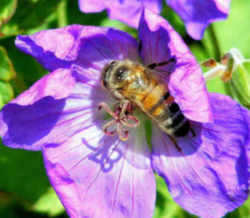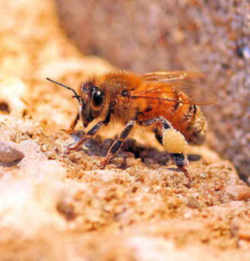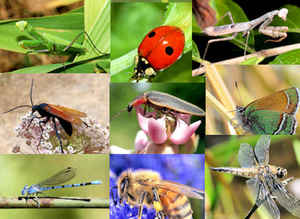Wisconsin State Insect
Honeybee

(Apis mellifera)
Adopted in 1977.
In 1977, the third grade class of Holy Family School in Marinette was studying the legislative process, hands-on. With encouragement from the Wisconsin Honey Producers Association, they asked the Legislature to select the honey bee, (Apis mellifera,) as Wisconsin state insect. The news got the school community abuzz. Attempts to get other elementary school students to help choose a state bug by popular ballot failed. The monarch butterfly, dragonfly, ladybug and mosquito were contenders for the title, but the honey bee won out. The honey bee was designated as the official state insect when Section 1.10 was amended by Chapter 326, Laws of 1977.
Did you know that: The honey bee has been proclaimed the official state insect in each of the following states:
Arkansas | Georgia | Kansas
| Kentucky | Louisiana
Maine | Mississippi |
Missouri | Nebraska | New Jersey
North Carolina | Oklahoma | South
Dakota | Tennessee
Utah | Vermont | West Virginia
| Wisconsin
Wisconsin State Insect: Honeybee

Bees produce honey as food stores for the hive during the long months of winter when flowers aren't blooming and therefore little or no nectar is available to them. European honey bees, genus Apis Mellifera, produce such an abundance of honey, far more than the hive can eat, that humans can harvest the excess. For this reason, European honey bees can be found in beekeeper's hives around the world!
Honeybees probably originated in Tropical Africa and spread from South Africa to Northern Europe and East into India and China. They were brought to the Americas with the first colonists and are now distributed world-wide. The first bees appear in the fossil record in deposits dating about 40 million years ago in the Eocene. At about 30 million years before present they appear to have developed social behavior and structurally are virtually identical with modern bees.
Characteristics of the Honeybee
Colony:
Honey bees are social insects, with a marked division of labor between the various types of bees in the colony. A colony of honey bees includes a queen, drones and workers.
The Queen:
The queen is the only sexually developed female in the hive. She is the largest bee in the colony.
A two-day-old larva is selected by the workers to be reared as the queen. She will emerge from her cell 11 days later to mate in flight with approximately
18 drone (male) bees. During this mating, she receives several million sperm cells, which last her entire life span of nearly two years.
The queen starts to lay eggs about 10 days after mating. A productive queen can lay 3,000 eggs in a single day.
The Drones:
Drones are stout male bees that have no stingers. Drones do not collect food or pollen from flowers. Their sole purpose is to mate with the queen. If the colony is short on food, drones are often kicked out of the hive.
The Workers:
Workers, the smallest bees in the colony, are sexually undeveloped females. A colony can have 50,000 to 60,000 workers.
The life span of a worker bee varies according to the time of year. Her life expectancy is approximately 28 to 35 days. Workers that are reared in
September and October, however, can live through the winter.
Workers feed the queen and larvae, guard the hive entrance and help to keep the hive cool by fanning their wings. Worker bees also collect nectar to
make honey. In addition, honey bees produce wax comb. The comb is composed of hexagonal cells which have walls that are only 2/1000 inch thick, but
support 25 times their own weight.
Honey bees' wings stroke 11,400 times per minute, thus making their distinctive buzz.
Wisconsin Law
The law designating the honeybee as the official Wisconsin state insect is found in the Wisconsin Statutes, Chapter 1, Section 1.10(3)(L)
CHAPTER 1. SOVEREIGNTY AND JURISDICTION OF THE STATE.
1.10. State song, state ballad, state waltz, state dance, and state symbols.
1.10(3) The Wisconsin state symbols are as follows:
1.10(3)(a)
(a) The mourning dove (zenaidura macroura corolinensis linnaus) is the symbol of peace.
1.10(3)(b)
(b) Milk is the state beverage.
1.10(3)(c)
(c) The sugar maple (acer saccharum) is the state tree.
1.10(3)(d)
(d) Corn (Zea mays) is the state grain.
1.10(3)(e)
(e) The wood violet (viola papilionacea) is the state flower.
1.10(3)(f)
(f) The robin (turdus migratorius) is the state bird.
1.10(3)(g)
(g) The muskellunge (Esox masquinongy masquinongy Mitchell) is the state fish.
1.10(3)(h)
(h) The badger (taxidea taxus) is the state animal.
1.10(3)(i)
(i) The dairy cow (bos taurus) is the state domestic animal.
1.10(3)(j)
(j) The white-tailed deer (odocoileus virginianus) is the state wildlife animal.
1.10(3)(k)
(k) The American water spaniel is the state dog.
1.10(3)(L)
(L) The honey bee (apis mellifera) is the state insect.
1.10(3)(m)
(m) The trilobite (calymene celebra) is the state fossil.
1.10(3)(n)
(n) Galena (lead sulfide) is the state mineral.
1.10(3)(o)
(o) Red granite is the state rock
1.10(3)(p)
(p) Antigo silt loam (typic glossoboralf) is the state soil.
1.10(3)(r)
(r) The cranberry (vaccinium macrocarpon) is the state fruit.
Taxonomic Hierarchy: Western Honey Bee
Kingdom: Animalia (Animals)
Phylum: Arthropoda (Arthropods)
Subphylum: Hexapoda (Hexapods)
Class: Insecta (Insects)
Order: Hymenoptera (Ants, Bees, Wasps and Sawflies)
No Taxon: (Aculeata - Ants, Bees and Stinging Wasps)
No Taxon: (Anthophila (Apoidea) - Bees)
Family: Apidae (Cuckoo, Carpenter, Digger, Bumble, and Honey Bees)
Subfamily: Apinae (Honey, Bumble, Long-horned, Orchid, and Digger Bees)
Tribe: Apini (Honey Bees)
Genus; Apis
Species: mellifera (Western Honey Bee)
Butterflies, and Bugs








